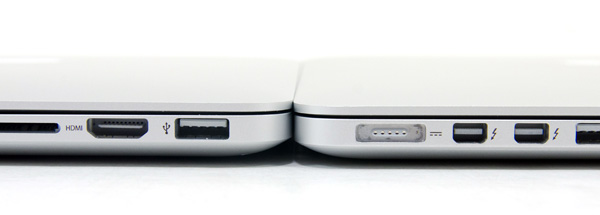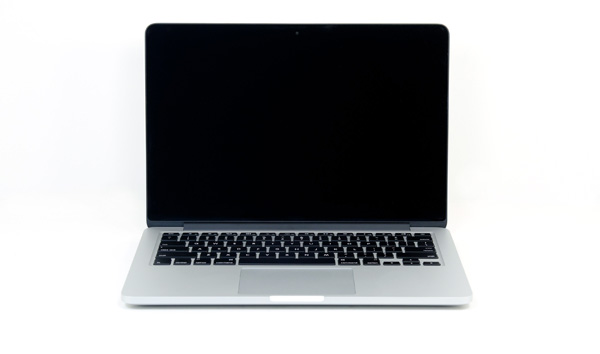13-inch Retina MacBook Pro Review (Late 2012)
by Anand Lal Shimpi on November 13, 2012 2:53 AM ESTFinal Words
When I reviewed it, I really liked the 15-inch Retina MacBook Pro. It's very fast, amazingly portable given its size and has a wonderful display. Its 13-inch counterpart, takes the portability to a completely different level. While I loved toting the 15 around (especially compared to its 2011 predecessor), it'd still feel like a burden after a long day of meetings. Using it in coach on most airlines was also problematic at times.
The 13-inch rMBP fixes the portability problem. Through a simple display switch, Apple's 13-inch MacBook Pro form factor went from uninteresting to perfect in my eyes. I do miss the larger display of the 15 from time to time, but the available scaled resolutions on the 13-inch rMBP make it a viable productivity machine. You don't sacrifice display quality at all in the move to the smaller panel. Brightness, contrast and color reproduction are all great. The MacBook Pro Retina Displays are easily the best Apple ships among all of its products.
Battery life is very good on the new machine thanks to its integrated 74Wh battery. Compared to a 15-inch rMBP, the 13-inch model delivers competitive battery life that is sometimes even better depending on whether or not the 15 has its dGPU active. Thermals and acoustics are also excellent thanks to the lower power components used inside.

13-inch rMBP (left) vs. 15-inch rMBP (right)
Then there are the givens: solid keyboard, trackpad, good WiFi, decent speakers and a well built chassis. The 13-inch rMBP retains all of these things.
You do give up performance in transitioning to the 13-inch Retina. You lose out on the quad-core CPU option and there's no room for a discrete GPU. If those matter to you, then you'll likely have to wait at least one more generation (maybe two) before Apple has a product that can satisfy all of your needs. I swapped out my 15-inch rMBP for the 13-inch model for the past couple of weeks in order to see if I'd really notice the performance difference. The lack of a dGPU wasn't terribly bothersome, but that's mostly because I didn't have time to play any games over the past couple of weeks. I definitely noticed the missing cores (and decrease in clock speed compared to the higher spec'd 15), although it wasn't something I couldn't get used to. Given how much I'm traveling lately, I'd almost say the loss of performance is worth it thanks to the weight and size reduction that you get with the 13. It's really a much easier notebook to travel with.
All of that being said, I don't really view the 13-inch rMBP as an alternative to the 15, but rather a step up from the MacBook Air. The MBA may be lighter, but Apple definitely blurred the line between the MBA and MBP with the 13-inch Retina. Performance is very similar between the two machines, but the rMBP's display is worlds better. For any power user, I don't know that I'd recommend the 13-inch MacBook Air over the 13-inch Retina MacBook Pro. It really is the best of both worlds.
Price is an obvious issue with all of the Retina MacBook Pro models. Apple did a great thing by outfitting all of the rMBPs with 8GB of memory, but the base $1699 configuration only comes with a 128GB SSD. Depending on your usage model, that may not be enough. Also if you're looking to minimize UI frame rate issues as much as possible you're going to want the upgraded CPU (although that still won't eliminate low UI frame rates). The problem is that upgrading both of these components together will set you back another $500 ($300 for the 256GB SSD and $200 for the faster CPU), putting the total system cost up at $2199. I would've liked to have seen a 256GB SSD in the base configuration at least. You do get a very good machine for the money, but it is a lot of money to spend.

13-inch rMBP (left) vs. 15-inch rMBP (right)
By far the biggest issue with buying the 13-inch MacBook Pro with Retina Display is that you know, in about a year, it'll be updated with even better hardware. It's very clear to me that the 13-inch rMBP was built with Haswell in mind. Without enough room for a discrete GPU, a CPU with significantly faster processor graphics (~2x in the case of Haswell) will open up the 13 to even more customers. Haswell should boast improvements in idle power, however since it's still built on Intel's 22nm process (like Ivy Bridge) it's not abundantly clear to me how active power will be impacted. Looking at the thermal data for the 13-inch rMBP alone leaves me comfortable saying there's some room to introduce more power hungry silicon without making the system unusable.
It rarely hurts to wait as there's almost always something better around the corner. If you are in the market for a Mac notebook however, the 13-inch MacBook Pro with Retina Display is a great option. It's not perfect. UI frame rates need help and the system is expensive, but it's easily the best balance of portability and productivity in Apple's lineup today.












79 Comments
View All Comments
KPOM - Tuesday, November 13, 2012 - link
The 13" MacBook Pro always had a dual core processor and never had discrete graphics. The Retina version is no different in that regard. If it isn't a "Pro" than neither is the non-Retina version.As an 11" MacBook Air user, the weight difference and extra thickness are more noticeable to me. Hopefully Apple comes out with an 11" MacBook Pro with Retina Display, since it does look very nice (I saw one in the store and it blew away the screen on my Air).
Arbee - Tuesday, November 13, 2012 - link
Agreed. Much as the original Air was basically an engineering placeholder waiting for SNB to make it good, this seems to be a placeholder waiting for at least Haswell, and possibly Broadwell.jeffbui - Tuesday, November 13, 2012 - link
Anand, your aspect ratio chart is off. The MBPs are still 16:10jeffbui - Tuesday, November 13, 2012 - link
Oops, looks like you switched the 16:9 chart with the 16:10 chart.iwod - Tuesday, November 13, 2012 - link
I wonder why Apple do not all stick to the same 16:10 ratio. The New iMac is 16:9, while all notebook are 16:10.Aenean144 - Wednesday, November 14, 2012 - link
iMacs have >20 inch screens. When you get that big, there's enough vertical screen space so that wider aspect ratio screens are tolerable.For smaller screen laptops, vertical space is at a premium. 16:10 is at best a compromise to me. Going to 16:9 would make it less usable.
yserr - Tuesday, November 13, 2012 - link
I have a MBP 15" (no Retina). I'm willing to give up GPU or quad, but not both, for portability.Do you think haswell will bring quad core to the 13" MBPr.
I think with the dismiss of the 17" and the trend to smaller, light devices. The 15" will be the new 17" and the 13" will be the new 15".
The 15" rMBP has two soldered ram banks the 13" rMBP has one.
Are there 16GB modules which are reasonable priced for one bank (which apple could offer)?
I will wait for haswell and than decide between 13" and 15".
My dream machine will be 13" rMBP with 16GB Ram and quad.... so I hope haswell will deliver my dream :-)
iwod - Tuesday, November 13, 2012 - link
Quad Core as standard and 2x Graphics Improvement. That is what i am hoping for as well. But with the 4x increase in Pixel count i doubt even Haswell is even good enough in Graphics Department. I just hope Broadwell will bring at least 3x performance over Haswell.yserr - Tuesday, November 13, 2012 - link
At least you see here (http://bit.ly/PalAfy - Haswell Preview) on the haswell slides that they will support 4k and High Resolution Displays. Lets see if they can deliver the performance needed for that. No question Broadwell will be better than Haswell. I hope Haswell will be fast enough for my needs.Kevin G - Tuesday, November 13, 2012 - link
Actually Ivy Bridge does support 4K displays if they are being driving by two DP.Haswell will implement DP 1.2 so it will be able to drive a 4K resolution display over a single cable. The GT3 + eDRAM versions of Haswell should be able to handle accelerated GUI without much issue. Gaming on the other hand at such high resolutions is something even high end GPU's (Radeon 7970, GTX 680) are struggling with.